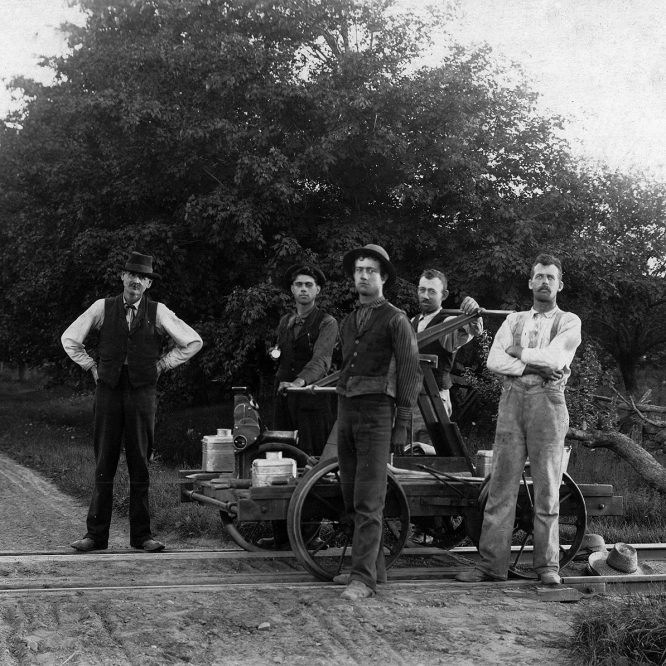Vol. 4, No. 33
This rather interesting photograph shows five men working as part of a section gang along the Rome, Watertown, and Ogdensburg Railroad. It is believed that this particular crossing was located somewhere in the town of Kendall and the photograph was taken September 11, 1897. The men appear to have stopped for dinner (the midday meal) as several metal pails appear on the car. One of the young men appears to be holding his pocket watch as if to show that it is noontime.
The Lake Ontario Shore Railroad was chartered in 1858, and like all great projects, was delayed for nearly ten years until the Lake Ontario Shore Railroad Company was formed on March 27, 1868. It would take another three years before construction commenced at Red Creek, New York and within two years the railway was operational from Ontario, Wayne County to Oswego. The rails eventually stretched to Kendall but the Panic of 1873 forced the company’s mortgage bonds to be called in early, which drove the railroad into bankruptcy.
On September 22, 1874 the line was sold to the Rome, Watertown, and Ogdensburg Railroad (RW&O) at foreclosure and on December 23, 1875 the Lake Ontario Railroad (as it was renamed) was consolidated into the RW&O Railroad. The railroad carried passengers for nearly sixty years, up to four trains each day, until June 1, 1933 when passenger traffic ceased. The railroad remained an important transportation line for freight travelling through the towns of Yates, Carlton, and Kendall.
These men, often called “Gandy Dancers,” played an important role in the maintenance of railroads throughout the United States. Although many section gangs were responsible for the construction of railroads, including the installation of new ties and rails, their daily maintenance routine was the most important part of the job. The term “Gandy” is derived from the five-foot-long metal “lining bar” used to reposition tracks. Throughout the course of regular use and travel, the vibrations of the train engine and cars as they passed over the rails would cause slight movements in the tracks. These many small “adjustments” would eventually create significant shifts in the tracks that could lead to derailments. Gandy dancers used their lining bars to realign the tracks to prevent the catastrophic consequences associated with freight and passenger derailment; the maneuvering of the pole by the section worker mimicked a dance.
The section gang’s arsenal of tools included the spike maul, used for driving railroad spikes, ballast forks and ballast tampers, used for repositioning and distributing ballast (stone under and around the railroad ties), as well as rail and tie tongs used for carrying wood and metal for replacing worn rails and rotten ties. This work required that gang members synchronize their motions, allowing for the appropriate distribution of their physical effort. The result was the creation of call-and-response songs that focused on railroad life, allowing workers to sync their labor to the rhythm of music.
In the south, section gangs were largely comprised of African Americans while northern section gangs typically consisted of immigrants. These jobs were entry-level positions at best, consisting of hard work and low wages. One particular example of this involved a local Irish immigrant, Michael Duggan who arrived in the U.S. in 1891. In 1945, he retired from the New York Central Railroad as a flagman, but started his employment as a section hand probably around the age of 24. The flagman was responsible for stopping street traffic as trains passed through; a much easier job than the manual labor of a section worker.
Standing front and center in this image is Charles Martin Vincent who was living in Kendall at the time this photograph was taken. He was approximately 24 years old and newly married, having wed his wife Ella Ireland on July 7, 1897. It is presumed that his work for the railroad was rather short-lived as he relocated to East Avenue in Holley by 1905 and worked for some time as a hardware store clerk for Ira Edwards.


